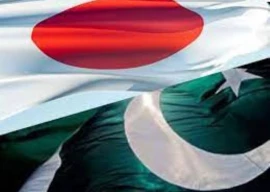
The interim government spent Rs191 billion on development projects during the first seven months of this fiscal year – a sum that is over Rs300 billion or 61% less than the target and underscores the implications of tough economic conditions.
The Ministry of Planning reported on Tuesday that the development expenditures amounted to just under Rs191 billion during July-January period of the current fiscal year. Its one-page summary sheet showed that the expenditures were equal to just 38% of the amount that the planning ministry had authorised for the spending for this period.
Under the Development Funds Releases Strategy, the government was required to spend Rs494 billion or 52% of the total annual budget during the first seven months of the fiscal year. But the actual spending was Rs300 billion less than the target.
The interim government has slowed down spending as part of its plan to meet the annual primary budget surplus target set by the International Monetary Fund. Despite slowing down expenditures during the first quarter, the government missed the target. The IMF gave a waiver to make Pakistan eligible for the $706 million tranche.
The significant gap between authorisation and actual expenditures underscores challenges in the fund release process, slow progress on schemes, and the capacity to spend allocated funds. Deliberate slowing down of development expenditures aims to offset higher current expenditures.
During the first review talks, Pakistan assured the IMF to fast-track spending after admitting delays in the expenditure of Public Sector Development Program (PSDP). Pakistan also committed to expedite the PSDP prioritisation and rationalisation process in line with recommendations, aiming to achieve savings of at least PRs 61 billion.
Last month, the National Economic Council asked provinces to take over 68 projects costing Rs121 billion. The NEC also placed a ban on further spending on parliamentarians’ schemes and prime minister’s initiatives. These three steps will save the centre a cost of Rs202 billion, including Rs112 billion during the current fiscal year.
Nonetheless, the chief ministers of Sindh and Khyber-Pakhtunkhwa (K-P) raised questions over the mandate of the caretaker government to make financial decisions having long-term implications. The chief minister of Sindh also cited Section 230 of the Election Act that limited the role of the caretaker government.
In its separate review of Pakistan’s public investment framework, the IMF has deemed Pakistan’s PSDP “unaffordable” due to limited fiscal space, noting a total cost of Rs12 trillion to complete approved projects, requiring over 14 years.
Read City’s development projects opened for Japan investors
The planning ministry’s report showed that 19% of total spending in seven months, or Rs35.6 billion, was on parliamentarians’ schemes. The last PDM government authorised Rs61.3 billion spending for these schemes, but the interim government slowed down the process. The annual budget is Rs90 billion.
For the current fiscal year, the government estimated the release of Rs75 billion in foreign loans. The disbursements reached Rs43 billion in seven months.
Development budget allocations for provinces, special areas, Azad Jammu & Kashmir, and Gilgit-Baltistan were affected in the first four months. Against the annual allocation of Rs170 billion, only Rs40 billion was spent, still the biggest spending head followed parliamentarians’ schemes.
The National Transmission and Dispatch Company (NTDC) and Pakistan Electric Power Company (PEPCO) spent Rs7 billion on its projects against the annual allocation of nearly Rs55 billion.
The National Highway Authority (NHA) has an annual budget of Rs157 billion. The planning ministry authorised Rs94 billion in spending, but actual expenses remained at only Rs21 billion. There was Rs30 billion spending on the water sector projects against the annual budget of Rs90 billion.
Only Rs261 million was spent against the Rs70 billion special programme for prime minister’s initiatives. The interim government stopped these releases, which former Prime Minister Shehbaz Sharif had set aside for projects of his own liking.
Where the federal government spent little on development, the provinces accelerated expenses under this head. The provincial spending exceeded projections in the first quarter, partly due to a Rs115 billion payment by the Punjab government to clear commodity operations debt and faster execution of PSDP.
Published in The Express Tribune, February 14th, 2024.
Like Business on Facebook, follow @TribuneBiz on Twitter to stay informed and join in the conversation.





















COMMENTS
Comments are moderated and generally will be posted if they are on-topic and not abusive.
For more information, please see our Comments FAQ